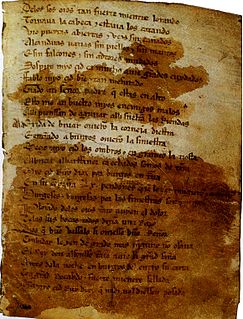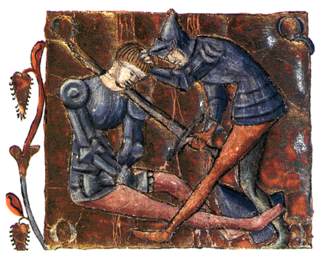
Rodrigo Díaz de Vivar was born in Vivar del Cid, a village near the city of Burgos and came to be known by the Moors as El Cid, and by the Christians as El Campeador.
A cantar de gesta is the Spanish equivalent of the Old French medieval chanson de geste or "songs of heroic deeds".

El Cantar de mio Cid, literally "The Song of my Cid", also known in English as The Poem of the Cid, is the oldest preserved Castilian epic poem. Based on a true story, it tells of the deeds of the Castilian hero Rodrigo Díaz de Vivar known as El Cid and takes place during the eleventh century, an era of conflicts in the Iberian Peninsula between the Kingdom of Castile and various Taifa principalities of Al-Andalus. It is considered a national epic of Spain.

Tizona is the name of one of the swords carried by Rodrigo Díaz de Vivar, El Cid, according to the Cantar de Mio Cid. The name of the second sword of El Cid is Colada.
Rodrigo is a Spanish, Portuguese and Italian name derived from the Germanic name Roderick, given specifically in reference to either King Roderic, the last Visigothic ruler or to Saint Roderick, one of the Martyrs of Córdoba . The modern given name has the short forms Ruy, Rui, and in Galician Roi.

Ramón Menéndez Pidal was a Spanish philologist and historian. He worked extensively on the history of the Spanish language and Spanish folklore and folk poetry. One of his main topics was the history and legend of El Cid. He was nominated for a Nobel Prize 23 times, the most nominated person, three times more than the second most nominated person, André Malraux.
Santa Gadea is a church dedicated to Saint Agatha in Burgos, Spain. The church is famous in history and literature for being the site where Rodrigo Díaz de Vivar at the behest of the Castilian Cortes, forced Alfonso VI to swear an oath that he was not an accomplice in the death of his brother, Sancho while he was besieging Zamora. Es el de la jura de Santa Gadea is the most notable Spanish medieval romance about this event.

Carrión de los Condes is a municipality in the province of Palencia, part of the Autonomous Community of Castile and León, Spain.

The Mocedades de Rodrigo is the name given to a late, anonymous Castilian cantar de gesta, composed around 1360, that relates the origins and exploits of the youth of the legendary hero El Cid.

Cetina is a municipality in the province of Zaragoza, Aragon. It is situated at an altitude of 666 metres (2,185 ft) in the south east of the province, in the Comunidad de Calatayud, some 176 kilometres (109 mi) north east of Madrid and 98 kilometres (61 mi) south west of Zaragoza. The population in 2011 was 687.
El Cid, or Rodrigo Diaz de Vivar, was a medieval Spanish hero.

The Castle of Jadraque is a castle in the municipality of Jadraque, Castile-La Mancha, Spain. It sits on a hill commanding the plain of the Henares river. It is sometimes called "Castle of Cid" as it is mentioned in the poem Cantar del Mio Cid.

The Battle of Bairén was fought between the forces of Rodrigo Díaz de Vivar, also known as "El Cid", in coalition with Peter I of Aragon, against the forces of the Almoravid dynasty, under the command of Muhammad ibn Tasufin. The battle was part of the long Reconquista of Spain, and resulted in a victory for the forces of the Kingdom of Aragon and the Kingdom of Valencia.

Torrelobatón Castle is situated in the province of Valladolid in Castile, Spain. Built as an expression of the strength of the influential Enríquez family, whose capital was at Medina de Rioseco, the castle is one of the most important and best-preserved fortresses in Valladolid. In the historical epic film El Cid with Charlton Heston the castle played the role of Vivar, hometown of Rodrigo Díaz de Vivar - El Cid.
Diego Fernández, also known as Diego Fernández de Oviedo, was a member of one of the most noble lineages of the Kingdom of León as the son of Fernando Flaínez and Elvira Peláez, daughter of count Pelayo Rodríguez. He was the second cousin of King Alfonso VI since both shared the same great-grandfather, Count Fernando Bermúdez de Cea. Distinguished with the title of Count at an early age, Diego was the father of Jimena Díaz, wife of Rodrigo Díaz de Vivar El Cid.

Jerome of Périgord, in Spanish Jerónimo, was a French monk who became the bishop of several dioceses in Spain. He was a companion of Rodrigo Díaz de Vivar, and in 1097 or 1098 became the bishop of Valencia after Rodrigo's conquest of the city. Forced to abandon it following Rodrigo's death, Jerome entered the service of Duke Raymond of Galicia in 1102 and became bishop over the churches in Salamanca, Ávila and Zamora.

The castle of Alcocer was a fortified Muslim village located in the archaeological site of La Mora Encantada in the Aragonese municipality of Ateca, Zaragoza, Spain.

The Way of El Cid is a cultural and tourist route that crosses Spain from the northwest to the southeast, from Castilla to the Mediterranean coast. It follows the history and the legend of Rodrigo Díaz de Vivar, El Cid Campeador, a medieval knight of the 11th century and one of Spain’s greatest characters. El Cid is not only a literary character, also a historical figure.
Cristina Rodríguez was a daughter of Rodrigo Díaz or El Cid and Jimena Díaz.
El Cid is a Spanish historical action drama streaming television series about Rodrigo Díaz de Vivar "El Cid", the 11th-century Castilian knight and warlord. Created by José Velasco and Luiz Arranz for Amazon Prime Video, the series stars Jaime Lorente alongside José Luis García Pérez, Elia Galera, Carlos Bardem, Alicia Sanz and Jaime Olías, among others. The 5-episode first season was released on Prime Video on December 18, 2020.













